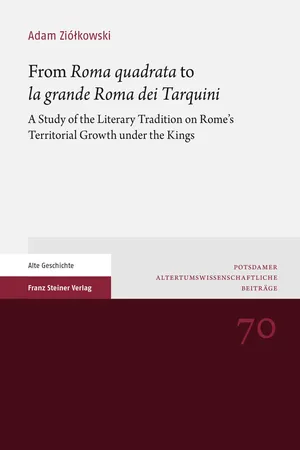
From "Roma quadrata" to "la grande Roma dei Tarquini"
A Study of the Literary Tradition on Rome's Territorial Growth under the Kings
- 354 pages
- English
- PDF
- Available on iOS & Android
From "Roma quadrata" to "la grande Roma dei Tarquini"
A Study of the Literary Tradition on Rome's Territorial Growth under the Kings
About this book
By the end of the regal period (late 6th c. BC) Rome was by far the greatest non-Greek city in Italy. How she attained her enormous size was a problem for the ancients no less than for the moderns. The former agreed on Rome's birth (the first city of the 8th c. BC on the Palatine's 15 hectares) and completion (all the traditional Seven Hills, ca. 400 hectares); everything in-between was a matter of dispute. The latter, while agreeing on the point of arrival, evidenced by the archaic remains of the 'Servian Wall', reject the point of departure and so the whole literary tradition on Rome's growth, pointing out that the Palatine was inhabited much earlier and the Capitol earlier still; another argument is a hypothetical huge (200–300 hectares) 'proto-urban centre' on Rome's site. The aim of this study is to assess the worth of the ancients' certainty that the Palatine was the city's cradle and see if their writings preserved dependable information on her growth; the results – Rome was in fact founded on the Palatine and had one stage of growth between the 'Romulean' birth and the 'Servian-Tarquinian' achievement – pass well the test of confrontation with the archaeological material.
Frequently asked questions
- Essential is ideal for learners and professionals who enjoy exploring a wide range of subjects. Access the Essential Library with 800,000+ trusted titles and best-sellers across business, personal growth, and the humanities. Includes unlimited reading time and Standard Read Aloud voice.
- Complete: Perfect for advanced learners and researchers needing full, unrestricted access. Unlock 1.4M+ books across hundreds of subjects, including academic and specialized titles. The Complete Plan also includes advanced features like Premium Read Aloud and Research Assistant.
Please note we cannot support devices running on iOS 13 and Android 7 or earlier. Learn more about using the app.
Information
Table of contents
- Table of Contents
- Foreword
- 1 Introduction
- 2 Before the City
- 3 Rome’s territorial growth in written sources1: The direct dossier
- 4 Rome’s territorial growthin written sources 2: The indirect dossier
- 5 Explaining Rome’s birth and growth Literary tradition and archaeological evidence
- Appendix AVarro, De lingua Latina 5.41–56
- Appendix B Tac. Ann. 12.24.1–2
- Appendix C Urban pagi and the earliest City
- Tables
- Figures
- Abbreviations
- Bibliography
- Indices